In an oft-overlooked corner of Chiapas in Mexico you will find one of the country’s liveliest festivals taking place in the shadow of one of its most captivating natural wonders.
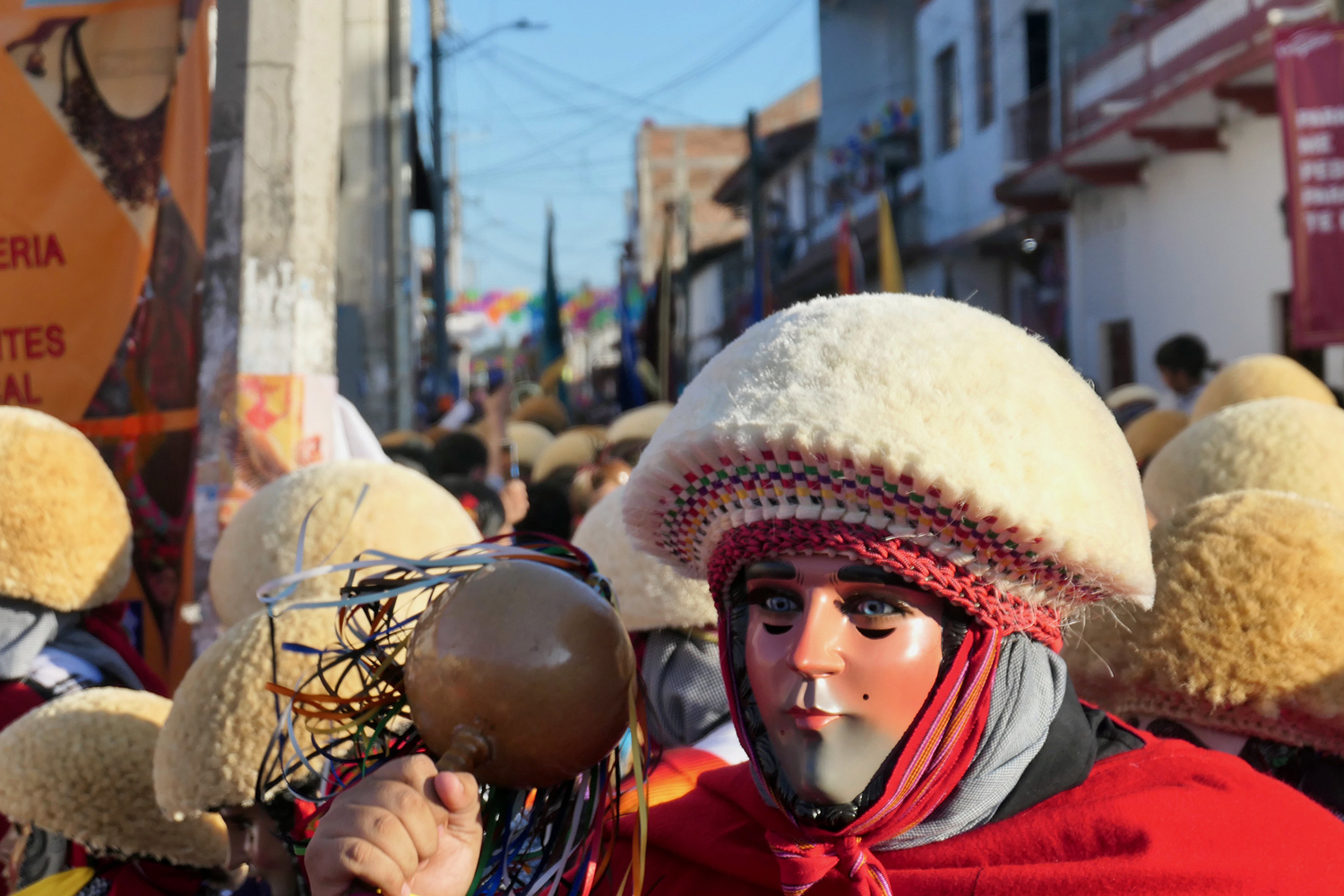
Parachico with a maraca (Photo: Bruno Rijsman via Flickr / CC BY-SA 2.0)
The sputtering diesel engine of the decrepit taxi battles with gravity, up and out of Tuxtla Gutiérrez, capital of Chiapas state. It’s hardly the quiet repose my partner and I had anticipated: escaping the city din, peppered with its occasional tinny trumpet-led refrains blasting through car radios, or from the speakers of gaily-painted breezeblock convenience stores. As the urban sprawl recedes from view, the single-lane road passes through impermeable low forest, said to be home to ocelots, white-tailed deer and spider monkeys.
When we disembark at the first viewpoint, nothing moves. Although only mid-morning, the air is sticky with heat. The low susurration of insects is the only indication that the uninviting tangle of greenery harbours anything other than plant life. We still can’t see the canyon, but given the regularity at which my ears popped on the way up, I know we must have climbed some considerable metres.
The path leads right up to the edge. Save for a few bushes and a small deciduous tree that has entangled its roots deep into cliff fissures, the drop is almost 1,000 metres straight down. My stomach churns a little as I lean out, peering at the mocha water far below. It’s as if somebody took a giant knife and sliced right through the planet; which is essentially what tectonics did to create the Sumidero Canyon in southern Mexico. And yet the thick vegetation on the opposite side feels almost close enough to jump across to.
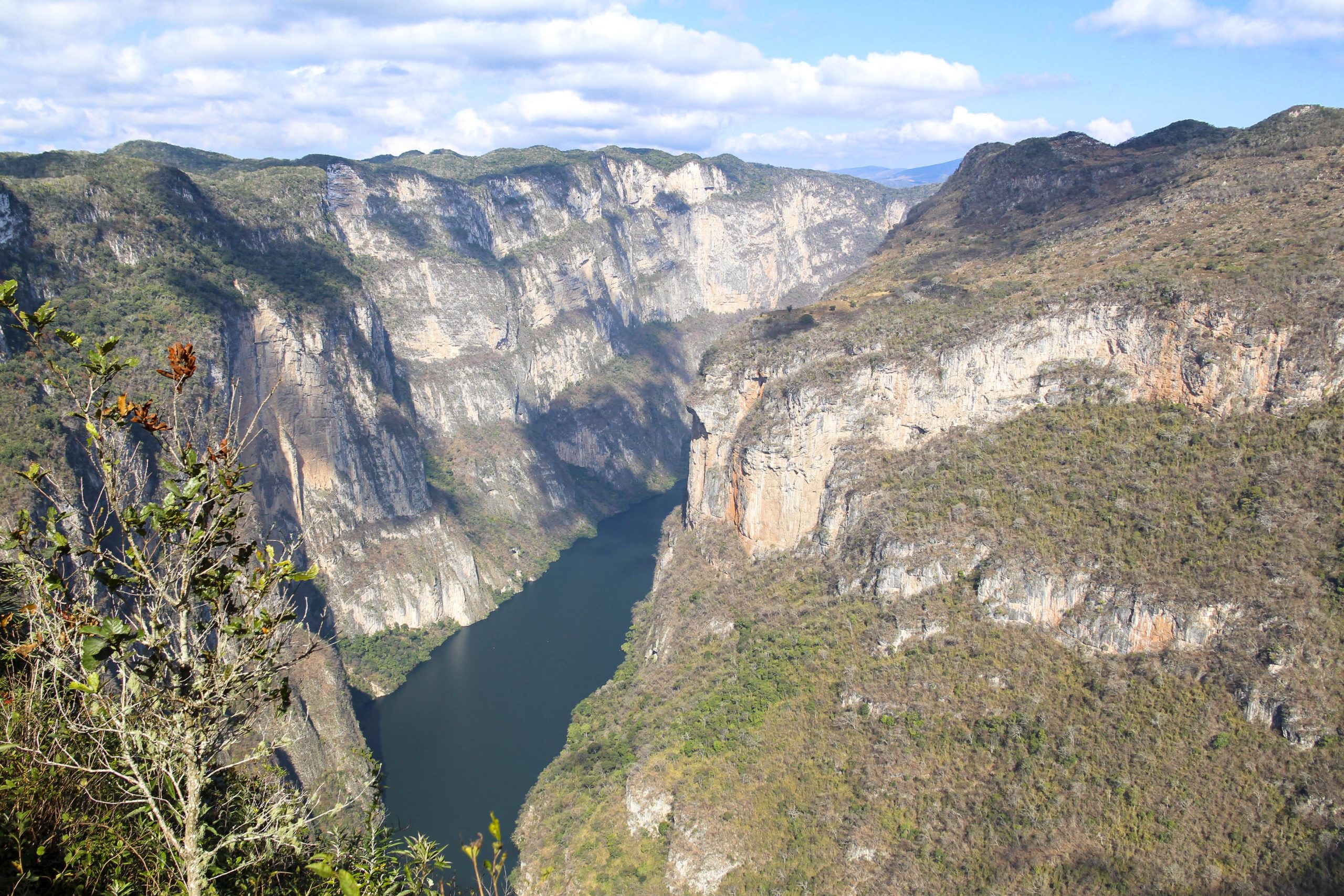
Sumidero Canyon (Photo: Paul Stafford for TravelMag)
Some readers will be quick to observe that at 1km deep in places, Sumidero is one of the world’s deepest canyons, although few people are likely to have ever heard of it. Surrounded by a leafy cordon of national park forest, which (mostly) prevents the encroachment of Tuxtla Gutiérrez on its southern fringe, and measuring only 8.1-miles (13km) long, Sumidero Canyon is indeed well concealed. And yet, its formation began around that same time as the Grand Canyon, which today is much deeper and vaster in scope; Sumidero’s smaller scale seems irrelevant though when you’re hanging over the edge.
On the way back down, we stop at another viewpoint overlooking the flatter land below. The steely ribbon of the Grijalva River looks like an anomaly; it flows from the plains of Chiapas into the mountain, rather than down from it, as though a geological doorway opens up allowing passage into the mountain’s core. It runs through the parted rock and twists somewhere into its interior, out of sight.
Sumidero Canyon was formed when a crack in the earth’s crust was pulled wider over time by tectonics, allowing an easier route for the river through the landmass than around it. This region of Mexico is no stranger to earthquakes either and, combined with the attrition of water, the canyon has been gradually sculpted in this unusual manner.
Skip to the geologically recent past and this fissure acted as a secretive conduit for Spanish invaders, who came through to conquer the surrounding land more rapidly, using the river to transport their weighty weapons of war. In fact, the river is still named after Juan de Grijalva, the first Spaniard to encounter the river from, and reveal these lands to, the West in 1518. Nowadays, the river no longer flows an unbroken course; at the northern end of the canyon it broadens into a reservoir before Chicoasén Dam, an eyesore created by the modern conquistadors of nature.
Way down on the river’s surface, a small white ‘V’ furrows the water, pointing south. It is one of the many tourist boats, which ply the river as far as the dam, heading home. I can just about make out smoke signals from its destination, Chiapa de Corzo, where the Spanish Conquistadors under the leadership of Diego de Mazariegos were to subjugate the Mesoamerican natives of this region in 1528. They rapidly put to an end a civilization that once produced some of the earliest writing and calendrical items to be found in Mexico.
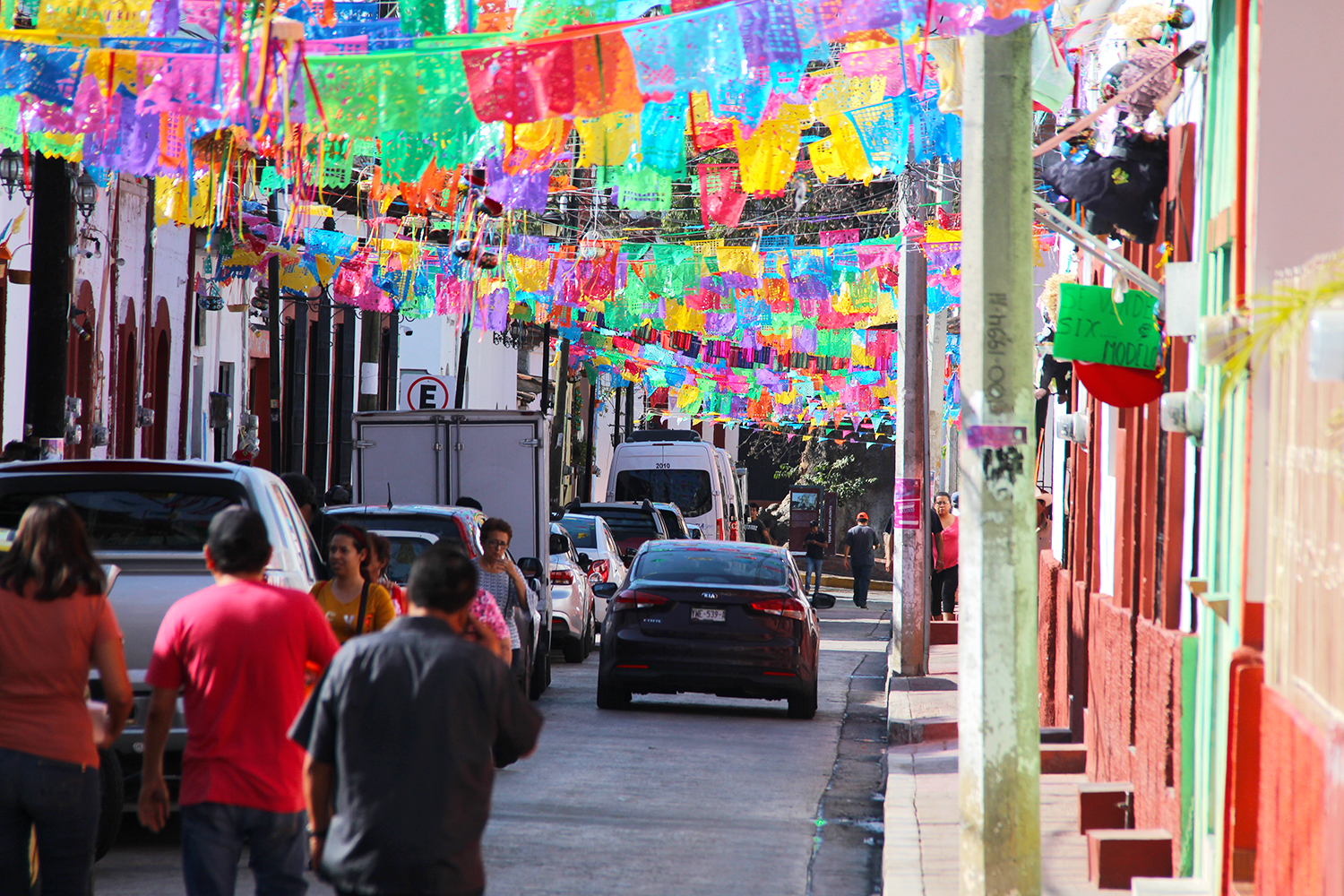
Colourful streets of Chiapa de Corzo (Photo: Paul Stafford for TravelMag)
Down into town
Chiapa de Corzo would normally be somnolent in the midday heat, but we arrive to find the town buzzing and completely closed off to traffic, including our bus. As is often the case in Mexico, three or four other passengers are quick to kindly point us in the right direction on noticing our confusion.
The polished cobblestones reflect the colourful bunting strung liberally above them as every street in town seems to be in some state of preparation for a huge party. It doesn’t take long to discover groups and families ambling in droves towards the river, while others are busily setting up stalls and amusements. The piles of rubbish being cleared away suggest quite a sizable affair the night before as well.
Parachicos, or the Fiesta Grande de Enero, is so unique and well established in Chiapas that it is inscribed on UNESCO’s Intangible Cultural Heritage List. We have arrived towards the end of the weeks-long event, and there’s a sense of weariness about many of the stall owners. Some try to nap in the shade, while three or four different sound systems vie for attention creating a frisson of discordant rhythms and notes. To make matters more unhinged, a roving band starts up in a nearby restaurant, treating diners to a whirlwind of cheap, out of tune drums accompanied by a plaintive trumpet.
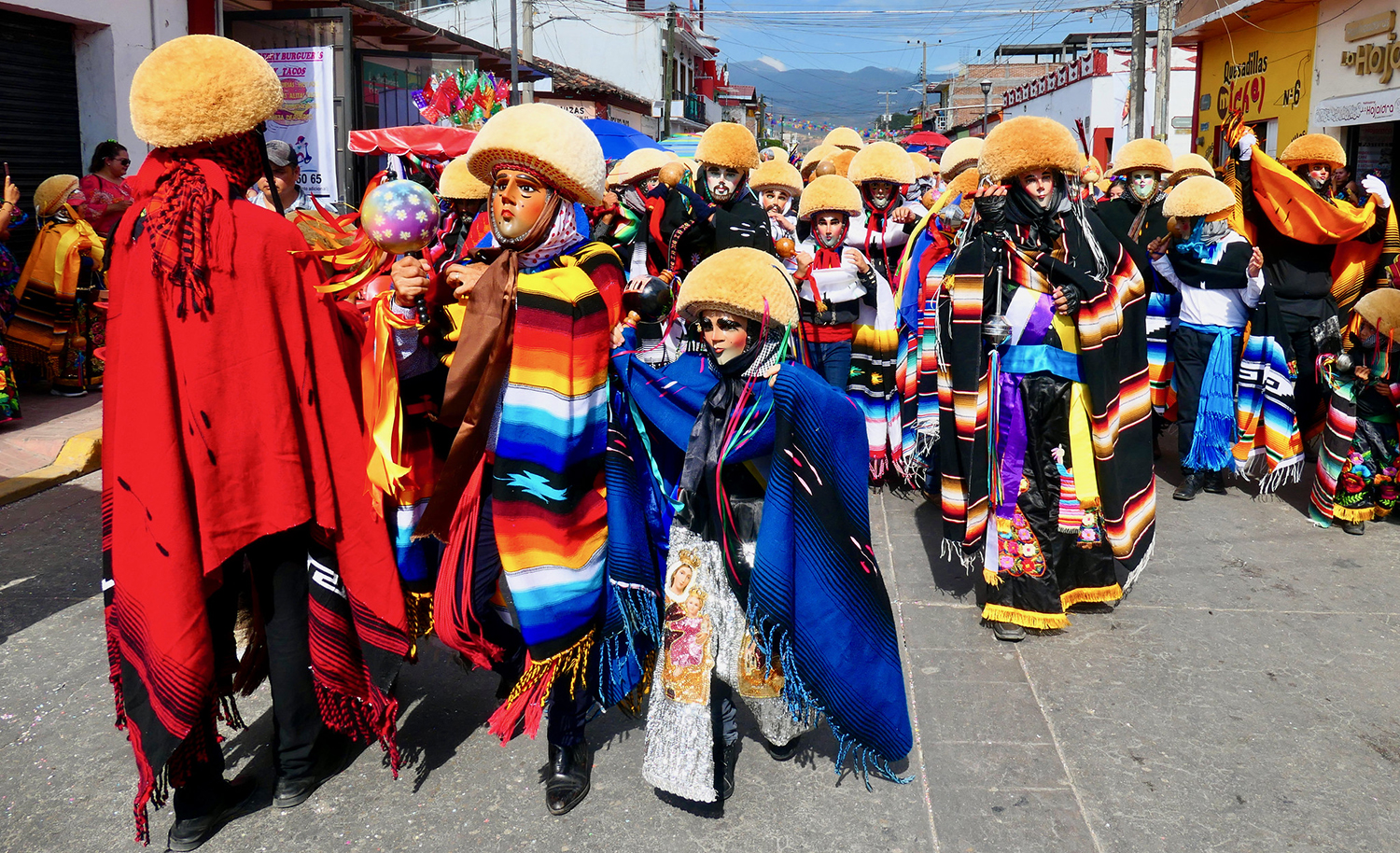
Procession of Parachicos (Photo: Bruno Rijsman via Flickr / CC BY-SA 2.0)
While the Fiesta Grande de Enero is primarily a religious celebration of various saints, including San Sebastian, it is best known for the Parachicos dancers, unique to this little corner of the country. The dancers’ costumes wryly satirize the Spaniards, with blonde straw wigs, bright cloaks and carved and lacquered white wooden masks. Essentially a mestizaje whiteface. They work their way through the crowds, carrying whips, which are brandished in a theatrical, playful way to chide onlookers. The masks are hand carved in a practice thought to date back to the 18th century. With UNESCO’s help, it is hoped that the skill of mask making will be passed on to future generations at a time when artisanal crafts are in decline in Mexico as much as the rest of the world.
We stop at a fruit seller’s cart for a tub of freshly sliced mango, the soft flesh sending juice down chins and dripping onto shirt fronts. I am told that the set-piece of the day is being arranged on the opposite bank of the river, which in the daylight appears to be little more than a gaggle of men carrying armloads of fireworks and placing them all along the bank.
On our side of the river, the owners of riverfront homes are busy assembling rows of wooden chairs in their gardens and selling tickets for the show. Although still rather unsure about what is going on, we each buy a ticket and are told to return an hour after dark.
We busy ourselves exploring the streets. The main square, normally a large, empty space punctuated by La Pila – a Moorish style fountain that demonstrates the North African empire’s impact on Spanish culture, while the Spanish, in turn, impacted that of Mexico – is now packed with rides and stalls. In a small pen, fluffy bunnies are up for grabs to anybody who can flip a coin onto a small plate floating atop a bucket of water, without it capsizing. Nobody seems able to do it.
We get lost in a rickety hall of mirrors for more time than two adults should respectably be trapped inside anything of their own volition. The smells of stale beer and grilled meats take turns in hijacking the air. Groups cluster around long tables spooning spicy salsas onto various dishes. Somewhere a squeal accompanies a mechanical swoosh, or somebody cheers a foosball goal.
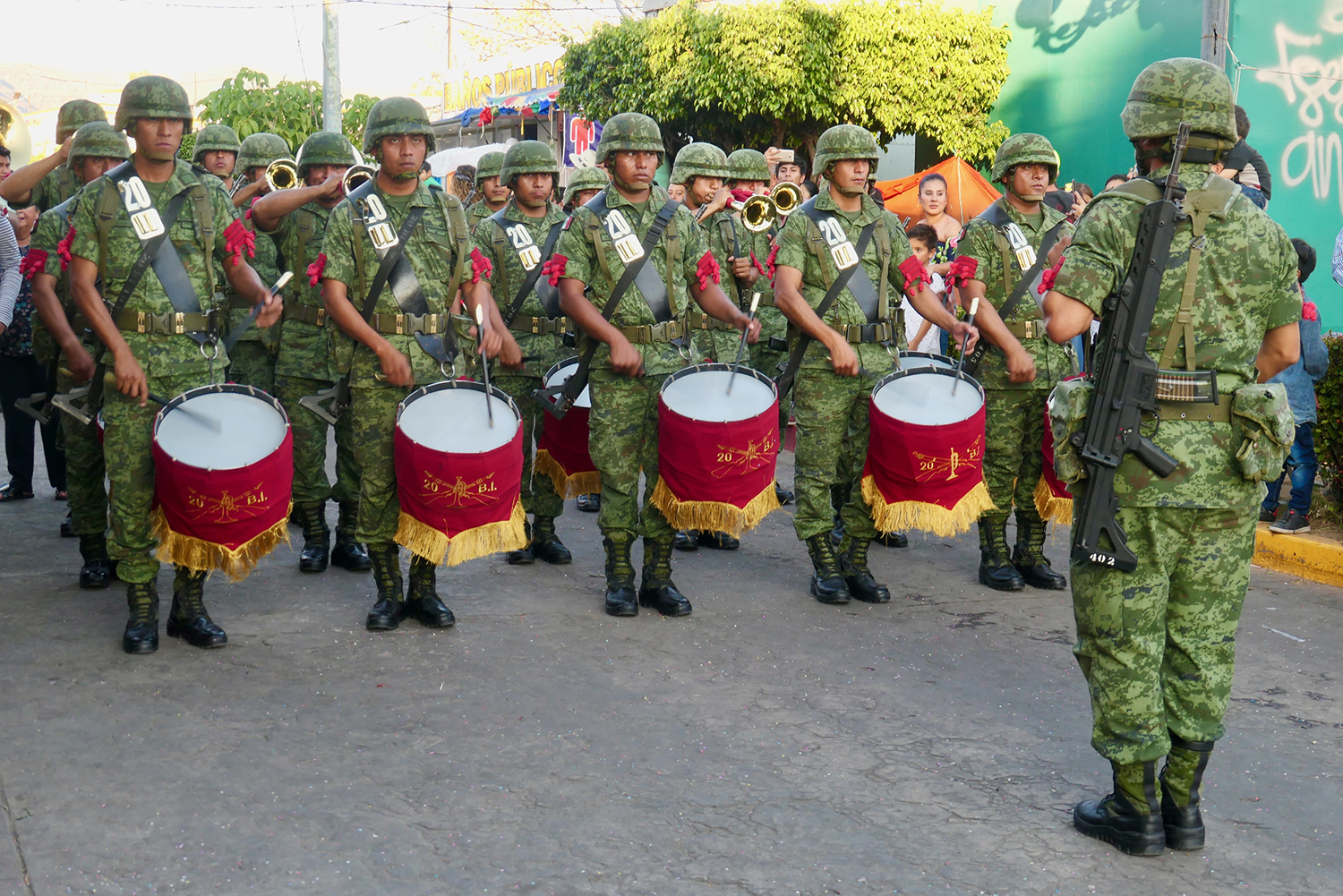
A military band during the festival (Photo: Bruno Rijsman via Flickr / CC BY-SA 2.0)
Explosive Displays
After dark, we return to the house where we bought tickets and are ushered into a front room. All the occupants’ possessions have been pushed into a corner and covered with a blanket. One or two younger members look at us quizzically; two European faces entering their home, as though a couple of the masked Parachicos have gotten lost and strayed in from the parade.
I’m told that the combate naval, or naval battle, is soon to start. We are told that it takes place every year on 21 January to commemorate local naval battles during the Spanish conquest, specifically that of 1528. Another local chimes in, stating that it’s actually a commemoration of the Battle of Chiapa de Corzo, a smaller skirmish that took place in 1863 between the then-independent Mexican Republic and France, whose almost six-year intervention in Mexico led to tens of thousands of deaths. But with so much European invasion, it’s hard to keep up with who is celebrating what.
Eventually, the consensus is that the event celebrates general indigenous bravery in the face of European invasion. We nod our thanks and squeeze into our seats, surrounded by families eating chili covered popcorn. A military band starts up with all its brass and snare bravura. Then there is a lull. People look around hesitantly as the minutes pass. Some are getting up to buy a beer as the first Catherine wheel fizzes into being. Then there’s another pause.

Colourful fireworks light up the night (Photo: Chris via Flickr / CC BY 2.0)
I notice a flotilla of boats move into the centre of the river. I’m half expecting there to be some huge recreation of a battle, but it’s just the tour boats, now filled with people who want a closer view of the action. When it does start, the 45-minute firework show is quite the pyrotechnical feat, each major cascade of molten chemicals casting eerie shadows over the boats as though doomed to succumb to the onslaught. And seeming to doom the boats below to collateral damage, although the embers always burn out harmlessly.
As it ends there’s a dull smoke that hangs limply into the air. People pour from the private homes, which make a fine days’ income out of the event, and into the pulsating streets. By now, every stall is heaving as countless speakers chime out banda and marimba hits. Although the Fiesta Grande de Enero may seem like a celebration of a colonially-imposed religion, it is unmistakably Mexican, I think to myself, as we are swept away from the river by the crowd’s tidal pull.
By now things are getting rowdy. Various brass bands compete with one another, firecrackers intermittently explode, and the carnival whirrs into life in a profusion of blurred lights and gleeful screams. Everything is underpinned by a characteristically Mexican lack of health and safety, which only seems to heighten the sense of revelry.
It’s quite touching that a defeat in battle is celebrated here. And after all, any excuse for a party is a good excuse. But in Mexico I had repeatedly discovered, as I do again now, that there’s no time to pine over sad histories, for the present is an undeniable product of that past. Like plate tectonics shape the land over time, human history can shape a people, and that is ultimately what is being celebrated in Chiapa de Corzo, in all its forms.